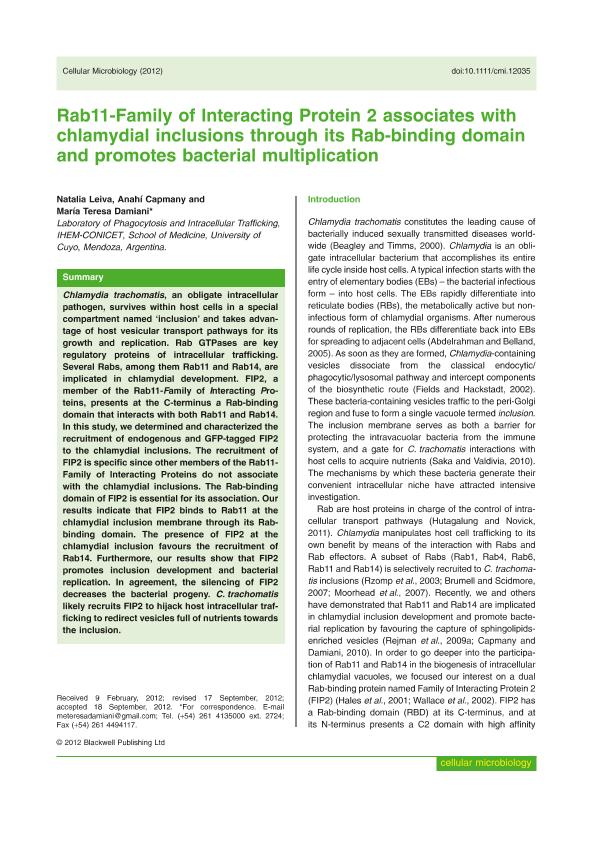Artículo
Rab11-Family of Interacting Protein 2 associates with chlamydial inclusions through its Rab-binding domain and promotes bacterial multiplication
Fecha de publicación:
01/11/2012
Editorial:
Wiley
Revista:
Cellular Microbiology
ISSN:
1462-5814
Idioma:
Inglés
Tipo de recurso:
Artículo publicado
Clasificación temática:
Resumen
Chlamydia trachomatis, an obligate intracellular pathogen, survives within host cells in a special compartment named ‘inclusion’ and takes advantage of host vesicular transport pathways for its growth and replication. Rab GTPases are key regulatory proteins of intracellular trafficking. Several Rabs, among them Rab11 and Rab14, are implicated in chlamydial development. FIP2, a member of the Rab11-Family of Interacting Proteins, presents at the C-terminus a Rab-binding domain that interacts with both Rab11 and Rab14. In this study, we determined and characterized the recruitment of endogenous and GFP-tagged FIP2 to the chlamydial inclusions. The recruitment of FIP2 is specific since other members of the Rab11- Family of Interacting Proteins do not associate with the chlamydial inclusions. The Rab-binding domain of FIP2 is essential for its association. Our results indicate that FIP2 binds to Rab11 at the chlamydial inclusion membrane through its Rabbinding domain. The presence of FIP2 at the chlamydial inclusion favours the recruitment of Rab14. Furthermore, our results show that FIP2 promotes inclusion development and bacterial replication. In agreement, the silencing of FIP2 decreases the bacterial progeny. C. trachomatis likely recruits FIP2 to hijack host intracellular traf- ficking to redirect vesicles full of nutrients towards the inclusion.
Palabras clave:
Fip2
,
Chlamydia Trachomatis
,
Intracellular Transport
,
Chlamydial Inclusions
Archivos asociados
Licencia
Identificadores
Colecciones
Articulos(IHEM)
Articulos de INST. HISTOLOGIA Y EMBRIOLOGIA DE MEND DR.M.BURGOS
Articulos de INST. HISTOLOGIA Y EMBRIOLOGIA DE MEND DR.M.BURGOS
Citación
Leiva, Natalia Lorena; Capmany, Anahi; Damiani, Maria Teresa; Rab11-Family of Interacting Protein 2 associates with chlamydial inclusions through its Rab-binding domain and promotes bacterial multiplication; Wiley; Cellular Microbiology; 15; 1; 1-11-2012; 114-129
Compartir
Altmétricas




